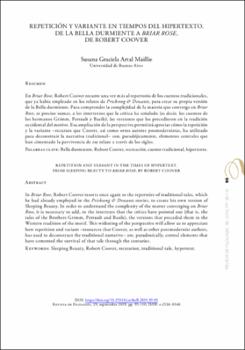Repetición y variante en tiempos del hipertexto. De la Bella durmiente a Briar Rose, de Robert Coover
Fecha
2019Resumen
En Briar Rose, Robert Coover recurre una vez más al repertorio de los cuentos tradicionales,
que ya había empleado en los relatos de Pricksong & Descants, para crear su propia versión
de la Bella durmiente. Para comprender la complejidad de la materia que converge en Briar
Rose, es preciso sumar, a los intertextos que la crítica ha señalado (es decir, los cuentos de
los hermanos Grimm, Perrault y Basile), las versiones que los precedieron en la tradición
occidental del motivo. Esa ampliación de la perspectiva permitirá apreciar cómo la repetición
y la variante –recursos que Coover, así como otros autores posmodernistas, ha utilizado
para deconstruir la narrativa tradicional– son, paradójicamente, elementos centrales que
han cimentado la pervivencia de ese relato a través de los siglos. In Briar Rose, Robert Coover resorts once again to the repertoire of traditional tales, which
he had already employed in the Pricksong & Descants stories, to create his own version of
Sleeping Beauty. In order to understand the complexity of the matter converging on Briar
Rose, it is necessary to add, to the intertexts that the critics have pointed out (that is, the
tales of the Brothers Grimm, Perrault and Basile), the versions that preceded them in the
Western tradition of the motif. This widening of the perspective will allow us to appreciate
how repetition and variant –resources that Coover, as well as other postmodernist authors,
has used to deconstruct the traditional narrative– are, paradoxically, central elements that
have cemented the survival of that tale through the centuries.





